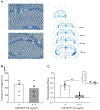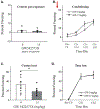The small conductance Ca2+-activated K+ channel activator GW542573X impairs hippocampal memory in C57BL/6J mice
- PMID: 38631563
- PMCID: PMC11792059
- DOI: 10.1016/j.neuropharm.2024.109960
The small conductance Ca2+-activated K+ channel activator GW542573X impairs hippocampal memory in C57BL/6J mice
Abstract
Small conductance Ca2+-activated K+ (SK) channels, expressed throughout the CNS, are comprised of SK1, SK2 and SK3 subunits, assembled as homotetrameric or heterotetrameric proteins. SK channels expressed somatically modulate the excitability of neurons by mediating the medium component of the afterhyperpolarization. Synaptic SK channels shape excitatory postsynaptic potentials and synaptic plasticity. Such SK-mediated effects on neuronal excitability and activity-dependent synaptic strength likely underlie the modulatory influence of SK channels on memory encoding. Converging evidence indicates that several forms of long-term memory are facilitated by administration of the SK channel blocker, apamin, and impaired by administration of the pan-SK channel activator, 1-EBIO, or by overexpression of the SK2 subunit. The selective knockdown of dendritic SK2 subunits facilitates memory to a similar extent as that observed after systemic apamin. SK1 subunits co-assemble with SK2; yet the functional significance of SK1 has not been clearly defined. Here, we examined the effects of GW542573X, a drug that activates SK1 containing SK channels, as well as SK2/3, on several forms of long-term memory in male C57BL/6J mice. Our results indicate that pre-training, but not post-training, systemic GW542573X impaired object memory and fear memory in mice tested 24 h after training. Pre-training direct bilateral infusion of GW542573X into the CA1 of hippocampus impaired object memory encoding. These data suggest that systemic GW542573X impairs long-term memory. These results add to growing evidence that SK2 subunit-, and SK1 subunit-, containing SK channels can regulate behaviorally triggered synaptic plasticity necessary for encoding hippocampal-dependent memory.
Keywords: Contextual memory; Fear memory; K(Ca)(2+); Learning; Object memory; Rodent.
Copyright © 2024 Elsevier Ltd. All rights reserved.
Conflict of interest statement
Declaration of competing interest The authors declare that they have no known competing financial interests or personal relationships that could have appeared to influence the work reported in this paper.
Figures




References
-
- Abiraman K, Sah M, Walikonis RS, Lykotrafitis G, Tzingounis AV, 2016. Tonic PKA activity regulates SK channel Nanoclustering and somatodendritic distribution. J. Mol. Biol 428, 2521–2537. - PubMed
-
- Adelman JP, Maylie J, Sah P, 2012. Small-conductance Ca2+-activated K+ channels: form and function. Annu. Rev. Physiol 74, 245–269. - PubMed
Publication types
MeSH terms
Substances
Grants and funding
LinkOut - more resources
Full Text Sources
Miscellaneous

